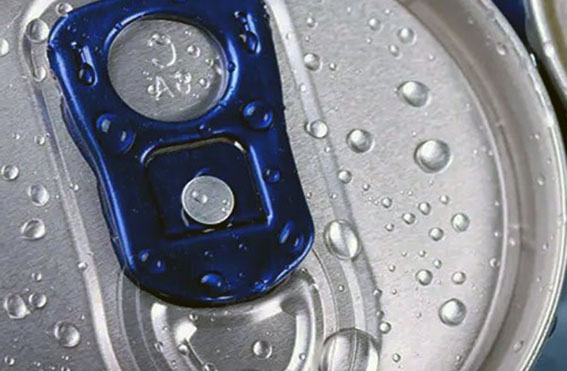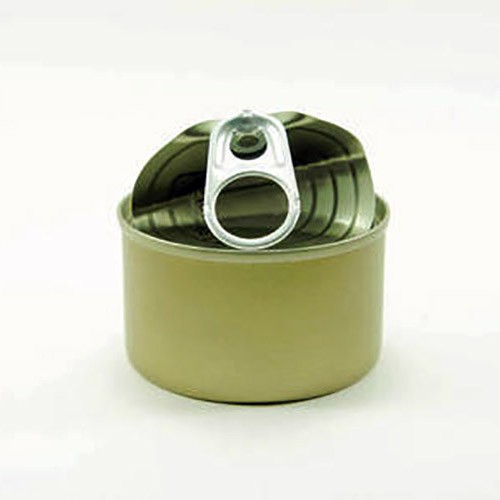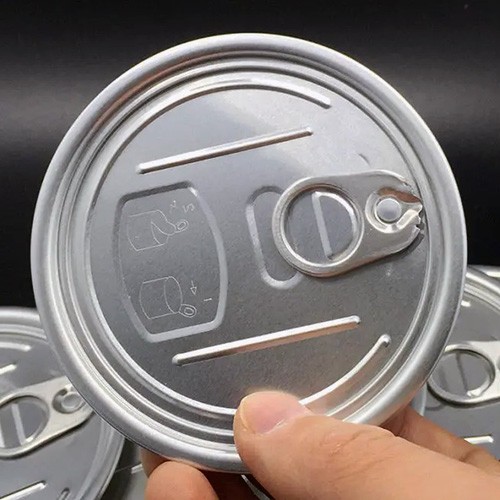5052 aluminum strip for ring pull can lid
Can lids are an important part of beverage and food packaging, ensuring product freshness, convenience and safety. At the heart of these lids is 5052 aluminum strip, which is known for its superior performance and serviceability.
Common parameters of 5052 aluminum ring can lid strips
- Thickness: 0.22-0.5mm
- Width: 1280mm
- 5052/5182: H19 alloy

Cans are widely used for packaging beverages, beer and other beverages. The lid, bottom, body and pull ring of cans can be made of aluminum alloy, which can save costs and minimize the weight of a single can to achieve lightness. Quantitative purposes.
5052 aluminum strip for ring pull can lid features
- (1) The pull tab material is generally processed by 5182 aluminum alloy, and the pull tab can cover material is generally processed by 5052 and 5182 aluminum alloy.
- (2) Good flexibility and not easy to crack due to stamping deformation.
- (3) Small density, light weight, smooth surface and good hand feel.
- (4) Environmentally friendly and easy to recycle and reuse.
Advantages of using 5052 aluminum plate for pull-tab can lids
- 1. Good plasticity, corrosion resistance and weldability.
- 2. Medium strength, good cold workability.
- 3. The surface has high smoothness and is suitable for post-processing.
- 4. Good printing effect and strong anti-counterfeiting ability.
- 5. Light weight, easy to carry, and the materials are recyclable.
5052 aluminum strip for pull-tab can lid specifications
| Aluminum Strip | 5052 |
| Temper | H14, H16, H18, H19, H48 |
| Thickness (mm) | 0.208-0.265 |
| Width (mm) | 515-1524 |
| Length (mm) | coils |
Quality requirements for 5052 aluminum sheets for pull-tab can lids
1. Flatness requirements
- No obvious waves are allowed on the surface of the strip.
- The height of waves within 1 meter shall not exceed 3mm, and the number of waves per meter shall not exceed 3.
2. Side curvature requirements
The side curvature of the product at any length of 2000mm should not be greater than 0.5mm.
3. End warpage requirements
For any product with a length of 1500mm, the end warpage height should be ≤5mm.
4. Connector requirements
No joints allowed.
5. Surface quality requirements
Defects that affect the appearance quality of the product, such as serious bubbles, missed plating, scratches, corrosion, oil spots, peeling, stripes, color difference, spots, roll marks, etc. are not allowed.
The burr height should be controlled below 0.04 mm.
6. End face quality requirements
- The ends are neat.
- There is no loose layer when rolled tightly.
- The misalignment shall not exceed 2mm.
- The tower shape does not exceed 5mm.
Earring of 5052 aluminum sheet strip and foil
| Temper | Earring |
| H18, H19 | ≤4% |
Unevenness of 5052 aluminum sheet strip and foil
| Thickness mm | 0.150-0.250 | >0.250-0.500 | ||
| Longitudinal unevenness | Wave height mm | not more than | 2 | 3 |
| Wave per meter length | 4 | 3 | ||
| Horizontal unevenness | Wave height mm | 1.5 | 1.5 | |
| Wave height mm | 2 | 2 | ||
Mechanical properties of 5052 aluminum strip
| Temper | H18 | H19 | ||
| Thickness mm | 0.200-0.500 | |||
| Mechanical properties | Tensile strength MPa | 280-320 | ≥285 | |
| Elongation % | Not less than | 3 | 2 | |
Chemical composition of 5052 aluminum strip
| Element | Content (%) |
| Aluminum, Al | Remainder |
| Magnesium, Mg | 2.2-2.8 |
| Chromium, Cr | 0.15-0.35 |
| Silicon, Si | ≤0.25 |
| Iron, Fe | ≤0.40 |
| Copper, Cu | ≤0.10 |
| Manganese, Mn | ≤0.10 |
| Zinc, Zn | ≤0.10 |
Applications of 5052 aluminum strip on pull-tab can lids
Pull-tab can lids play a vital role in maintaining the freshness and quality of packaged beverages and food products while providing convenience to consumers. The use of 5052 aluminum tape in these covers is used in a variety of industries including:
- Beverage Packaging: Carbonated drinks, juices, energy drinks and other beverages often use pull-tab can lids made from 5052 aluminum strip. The alloy's corrosion-resistant properties ensure the lid remains intact even in acidic or carbonic environments, preventing contamination and leakage.
- Food packaging: Canned foods such as soups, vegetables and pet food rely on pull-tab lids to seal and preserve. Aluminum's inertness makes it ideal for food contact applications, ensuring that package contents remain safe and intact.
- Drug Packaging: Some drugs, especially those in liquid or aerosol form, are packaged in jars with pull-tab lids. The air-tight seal provided by these lids prevents moisture from entering and maintains product efficacy throughout shelf life.
- Industrial and Chemical Packaging: Chemicals, lubricants and industrial fluids packaged in cans with pull-tab lids benefit from the corrosion-resistant properties of 5052 aluminum strip. This ensures product integrity during storage and transportation, even in harsh industrial environments.

5052 aluminum strip for ring pull can lid production control
(1) Strictly control good width tolerances.
- Thickness tolerance: +0.01mm (0.005mm preferred)
- Width tolerance: +1mm
- Flatness requirements: height less than 3mm, wave number within 1 meter less than 3.
(2) Mechanical properties
- Yield strength: 295-380Mpa
- Tensile strength: 355-420 MPa
- Delay rate: 5.5%
(3) Shape control
The combination of rollers, bending rollers, and spraying are used to control the flatness well, ensuring that the thermal machine crown is controlled between 0.1 and 0.8%, and there are no obvious visual waves on the hot line.
(4) Appearance quality
There are no cracks on the edge, the rolled ends are neat, and there is no staggered pyramid shape.
Casting process control points
- (1) Control the sodium content to avoid excessive sodium content and sodium brittleness.
- (2) Pay attention to adding gas and refining it to prevent large cracks and cracks in subsequent rolling.
- (3) Pay attention to the metallurgical quality of the slag primary gas to prevent the slag from causing the customer to explode the tank during use.
5052 aluminum strip for pull-tab can lid manufacturing process
The production of 5052 aluminum strip for pull-tab can lids involves several complex steps, each of which contributes to the quality and performance of the material:
- Alloy Preparation: The process begins with the precise mixing of raw materials to obtain the desired aluminum alloy composition. This step involves carefully controlling the proportions of aluminum, magnesium, chromium and other alloying elements to meet specified properties.
- Casting: After the alloy composition is determined, it is melted in a furnace and cast into ingots or billets. The casting process ensures the uniformity and purity of the material, laying the foundation for subsequent processing.
- Rolling: The cast aluminum is then hot rolled into thin strip of the desired thickness. Rolling reduces the thickness of the material while improving its mechanical properties and surface finish. Cold rolling can also be used to achieve further dimensional accuracy and surface smoothness.
- Annealing: In order to eliminate internal stress and enhance formability, rolled aluminum strip needs to be annealed, which is a heat treatment process that involves heating the material to a specific temperature and then gradually cooling it. Annealing also improves the machinability of the strip, facilitating subsequent forming operations.
- Surface treatment: Aluminum strips can use cleaning, degreasing, coating and other surface treatment processes to enhance their appearance, corrosion resistance and adhesion. These treatments ensure that the finished tab-top can lids meet the packaging industry's stringent quality standards.
5052 aluminum strip for ring pull can lid hot rolling process
- (1) Hot rolling mill technology: large single side milling 15-20mm, side milling 10-15mm.
- (2) Heating system: furnace gas temperature 490 degrees, heat preservation for 33 hours, baking temperature 475-485.
- (3) Drum type: -0.02mm.
- (4) Emulsification index: based on the actual production conditions during hot rolling.
- (5) Unloading thickness: To meet the process requirements, it is between 6.0-6.5mm, and should be controlled by the lower limit as much as possible.
- (6) Surface control: On a flat road surface, the first and second coils can have a uniform white color. The final coil will have a metallic luster and uniform color through the sub-surface exposure, without white aluminum adhesion. The surface is not allowed to have scratches, scrapes, sand holes and other deep defects. It can have mild steel marks, mild trachoma, slight pitting, and the edges can be cut within the weight range of the skin edge.
- (7) Flatness control: Use rollers, bending rollers, and spraying to control the flatness well, ensuring that the heat machine 8 crowns are controlled between 0.1 and 0.8%, and there are no obvious visual waves on the heat line.
- (8) Appearance quality: End face edge cracks, roll surface neat, no staggered pyramid shape.
From beverage and food packaging to pharmaceutical and industrial applications, tab-top can lids made from 5052 aluminum strip provide reliable sealing, convenience and protection for a variety of products.








